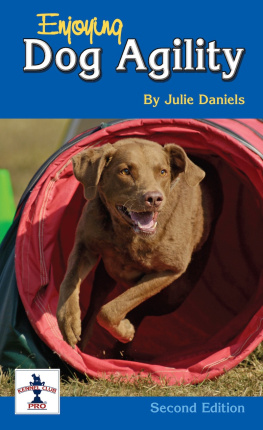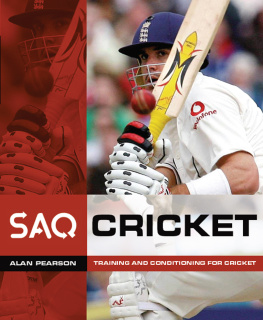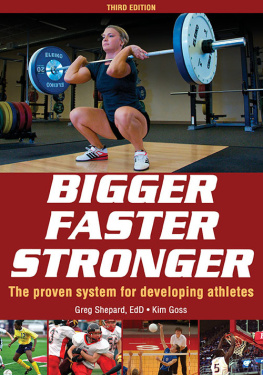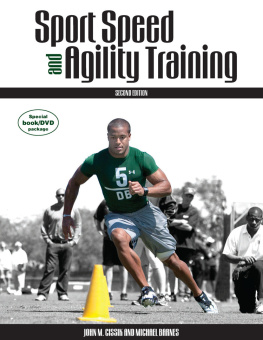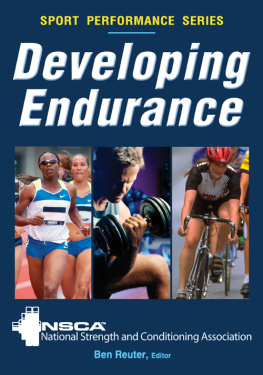Developing Agility and Quickness
National Strength and Conditioning Association

Jay Dawes
Mark Roozen
EDITORS

Library of Congress Cataloging-in-Publication Data
Developing agility and quickness / Jay Dawes, Mark Roozen, editors.
p. cm.
Includes bibliographical references and index.
ISBN-13: 978-0-7360-8326-3 (soft cover)
ISBN-10: 0-7360-8326-X (soft cover)
1. Sports sciences. 2. Sports--Physiological aspects. 3. Motor ability. 4. Motor learning. I. Dawes, Jay. II. Roozen, Mark, 1961- III. National Strength & Conditioning Association (U.S.)
GV558.D45 2011
613.71--dc23
2011025357
ISBN-10: 0-7360-8326-X (print)
ISBN-13: 978-0-7360-8326-3 (print)
Copyright 2012 by National Strength and Conditioning Association
All rights reserved. Except for use in a review, the reproduction or utilization of this work in any form or by any electronic, mechanical, or other means, now known or hereafter invented, including xerography, photocopying, and recording, and in any information storage and retrieval system, is forbidden without the written permission of the publisher.
The web addresses cited in this text were current as of June 2011, unless otherwise noted.
Developmental Editor: Heather Healy; Assistant Editor: Claire Marty; Copyeditor: Joy Wotherspoon; Indexer: Nan N. Badgett; Permission Manager: Martha Gullo; Graphic Designer: Joe Buck; Graphic Artist: Julie L. Denzer; Cover Designer: Keith Blomberg; Photographer (cover): Ben Liebenberg/NFL via Getty Images; Photographer (interior): Neil Bernstein, Human Kinetics, unless otherwise noted; Photo Asset Manager: Laura Fitch; Visual Production Assistant: Joyce Brumfield; Photo Production Manager: Jason Allen; Art Manager: Kelly Hendren; Associate Art Manager: Alan L. Wilborn; Art Style Development: Joanne Brummett; Illustrations: Human Kinetics, unless otherwise noted; Printer: Sheridan Books
We thank the National Strength and Conditioning Association in Colorado Springs, Colorado, for assistance in providing the location for the photo shoot for this book.
Human Kinetics books are available at special discounts for bulk purchase. Special editions or book excerpts can also be created to specification. For details, contact the Special Sales Manager at Human Kinetics.
Printed in the United States of America 10 9 8 7 6 5 4 3 2 1
The paper in this book is certified under a sustainable forestry program.
Human Kinetics
Website: www.HumanKinetics.com
United States: Human Kinetics
P.O. Box 5076
Champaign, IL 61825-5076
800-747-4457
08 8372 0999
e-mail: humank@hkusa.com
Canada: Human Kinetics
475 Devonshire Road Unit 100
Windsor, ON N8Y 2L5
800-465-7301 (in Canada only)
e-mail: info@hkcanada.com
Europe: Human Kinetics
107 Bradford Road
Stanningley
Leeds LS28 6AT, United Kingdom
+44 (0) 113 255 5665
e-mail: hk@hkeurope.com
Australia: Human Kinetics
57A Price Avenue
Lower Mitcham, South Australia 5062
08 8372 0999
e-mail: info@hkaustralia.com
New Zealand: Human Kinetics
P.O. Box 80
Torrens Park, South Australia 5062
0800 222 062
e-mail: info@hknewzealand.com
Developing Agility and Quickness
Contents
Introduction
For all athletes, the ability to quickly change direction is often the difference between success and failure. Virtually all sports involve whole-body movements that require athletes to rapidly and instantly accelerate, decelerate, or change direction in response to game situations. The reality is that in most sports, the ability to quickly change direction is more important than great straight-line sprinting speed. For this reason, many coaches and athletes are interested in finding effective ways to improve agility and quickness. The purpose of this book is to assist sports coaches, athletes, and strength and conditioning professionals in accomplishing this goal.
In 2002, Young, Jones, and Montgomery attempted to identify the most significant factors influencing agility performance. In particular, these authors divided agility performance variables into two main areas: change of direction speed and perceptual and decision-making factors. An example is a kick or punt returner in American football waiting patiently to receive a ball who must immediately decide which way to maneuver through the defense to gain yardage. Or, imagine a point guard who dribbles down the lane and must determine whether to continue dribbling, pass the ball, or shoot. These are prime examples of how athletes must move and think fast to achieve lightning quickness on the field or court. Therefore, to maximize performance, athletic training programs must address both the physical and cognitive components of agility and quickness. Only then will athletes be able to truly bridge the gap between practice and competition.
discusses factors that influence agility, such as change-of-direction speed, proper technique, body position, and physical attributes. It also covers the essential components of developing rapid force, high power output, and explosive movement, as well as how these fundamental attributes influence athletes ability to achieve high-level performance.
explores perceptual and decision-making skills (i.e., quickness factors), such as information processing, knowledge of situations, anticipation, and arousal and anxiety levels. Athletes with high-level agility performance are better at recognizing and capitalizing on task- and game-relevant cues that give them a competitive advantage over their opponents. In many cases, these skills separate elite performers from everyone else.

Figure 1 Components of agility.
Adapted, by permission, from W.B. Young, R. James, and I. Montgomery, 2002, Is muscle power related to running speed with changes of direction? Journal of Sports Medicine and Physical Fitness 42(3):282-288.
As with any training program, athletes must be physically prepared for the demands of training. Agility and quickness training is no different. Therefore, prior to the chapters with specific drills to enhance agility and quickness ( discusses techniques to evaluate an athletes readiness in detail. This chapter also presents methods for monitoring athletes progress with both qualitative-movement assessments and tests that predict agility performance.
decision-making tasks into athletes training programs once they have mastered the techniques. These unplanned, or open, drills require athletes to process information from the environment and to respond quickly with accuracy and precision.
The selected drills provide a solid base of information to assist in the development of athlete-specific and sport-specific training programs. , professionals from a variety of sports share their personal philosophies on agility and quickness training and their favorite drills for improving sport performance at a variety of skill levels. The drills in this chapter add sport-specific training stimulus to the program, which better prepares athletes for the chaotic nature of sport and competition.


